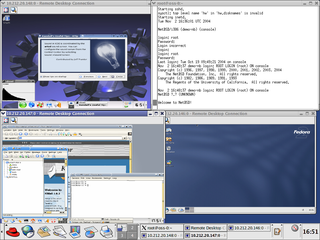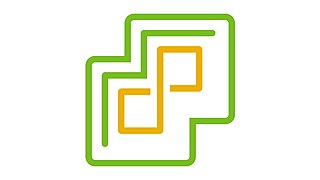Related Research Articles

Citrix Systems, Inc. is an American multinational cloud computing and virtualization technology company that provides server, application and desktop virtualization, networking, software as a service (SaaS), and cloud computing technologies. Citrix claims that their products are used by over 400,000 clients worldwide, including 99% of the Fortune 100 and 98% of the Fortune 500.

VMware LLC is an American cloud computing and virtualization technology company headquartered in Palo Alto, California. VMware was the first commercially successful company to virtualize the x86 architecture.

Xen is a free and open-source type-1 hypervisor, providing services that allow multiple computer operating systems to execute on the same computer hardware concurrently. It was originally developed by the University of Cambridge Computer Laboratory and is now being developed by the Linux Foundation with support from Intel, Citrix, Arm Ltd, Huawei, AWS, Alibaba Cloud, AMD, Bitdefender and EPAM Systems.
Platform virtualization software, specifically emulators and hypervisors, are software packages that emulate the whole physical computer machine, often providing multiple virtual machines on one physical platform. The table below compares basic information about platform virtualization hypervisors.

Desktop virtualization is a software technology that separates the desktop environment and associated application software from the physical client device that is used to access it.
VMware Workstation Pro is a hosted hypervisor that runs on x64 versions of Windows and Linux operating systems. It enables users to set up virtual machines (VMs) on a single physical machine and use them simultaneously along with the host machine. Each virtual machine can execute its own operating system, including versions of Microsoft Windows, Linux, BSD, and MS-DOS. VMware Workstation is developed and sold by VMware, which has been owned by Broadcom since November 2023. In May 2024, Workstation Pro became free of charge for personal use, with paid subscriptions available for commercial use, while the free restricted VMware Workstation Player was dropped. In November 2024, VMware Workstation was made free for commercial use, with paid subscriptions and support no longer available.

VMware ESXi is an enterprise-class, type-1 hypervisor developed by VMware, a subsidiary of Broadcom, for deploying and serving virtual computers. As a type-1 hypervisor, ESXi is not a software application that is installed on an operating system (OS); instead, it includes and integrates vital OS components, such as a kernel.
VMware Fusion is a software hypervisor developed by VMware for macOS systems. It allows Macs with Intel or the Apple M series of chips to run virtual machines with guest operating systems, such as Microsoft Windows, Linux, or macOS, within the host macOS operating system.
Pano Logic was a manufacturer of devices which present virtual desktops to the end user with no local processing power. They describe this concept as "zero client". This is perceived as offering benefits in end-user support and in power provision to desks. OEM versions have been included in displays from some vendors, allowing a single unit to be deployed. The company failed in October 2012. In March 2013, Propalms announced they had acquired the rights to support Panologic customers, and will "help transition the customer base to a new platform".

In computing, virtualization is a series of technologies that allows dividing of physical computing resources into a series of virtual machines, operating systems, processes or containers. Virtualization began in the 1960s with IBM CP/CMS. The control program CP provided each user with a simulated stand-alone System/360 computer.

VMware vSphere is VMware's cloud computing virtualization platform.
XenClient is a discontinued desktop virtualization product developed by Citrix. It runs virtual desktops on endpoint devices. The product reached end of-life in December 2016. XenClient runs both operating system and applications locally in the end users device, without the need for a connection to a data center, which is why it is used in environments with limited connectivity, disconnected operation on laptops, and other scenarios where local execution is desired while keeping management centralized.
Wanova, Inc, headquartered in San Jose, California, provides software allowing IT organizations to manage, support and protect data on desktop and laptop computers. Wanova's primary product, Wanova Mirage, was designed as an alternative to server-hosted desktop virtualization technologies.
CloudStack is open-source Infrastructure-as-a-Service cloud computing software for creating, managing, and deploying infrastructure cloud services. It uses existing hypervisor platforms for virtualization, such as KVM, VMware vSphere, including ESXi and vCenter, XenServer/XCP and XCP-ng. In addition to its own API, CloudStack also supports the Amazon Web Services (AWS) API and the Open Cloud Computing Interface from the Open Grid Forum.

Teradici Corporation was a privately held software company founded in 2004, which was acquired by HP Inc. in October 2021. Teradici initially developed a protocol (PCoIP) for compressing and decompressing images and sound when remotely accessing blade servers, and implemented it in hardware. This technology was later expanded to thin clients/zero clients for general Virtual Desktop Infrastructure. Teradici's protocol or hardware is used by HP, Dell subsidiary Wyse, Amulet Hotkey, Samsung, Amazon Web Services, Fujitsu, and VMware.

2X Software was a Maltese software company specializing in virtual desktop, application virtualization, application delivery, Remote Desktop Services, remote access and Mobile Device Management. On 25 February 2015, 2X Software was acquired by Parallels, Inc. The 2X products, Remote Application Server and Mobile Device Management, are now included in Parallels' offering.
GPU virtualization refers to technologies that allow the use of a GPU to accelerate graphics or GPGPU applications running on a virtual machine. GPU virtualization is used in various applications such as desktop virtualization, cloud gaming and computational science.
Citrix Virtual Apps is an application virtualization software produced by Citrix Systems that allows Windows applications to be accessed via individual devices from a shared server or cloud system.
Ericom Connect is a remote access/application publishing solution produced by Ericom Software that provides secure, centrally managed access to physical or hosted desktops and applications running on Microsoft Windows and Linux systems.
Citrix Virtual Desktops is a desktop virtualization product.
References
- ↑ "VMware Horizon 2006". VMware Customer Connect. VMware, Inc. Retrieved 15 September 2022.
- ↑ "VMware Announces General Availability of VMware View 3, with Ground-Breaking Advances in Managing, Scaling and Personalizing Virtual Desktop Environments". VMware News Release. Palo Alto: VMware. 2008-12-02. Retrieved 2010-08-12.
PALO ALTO, Calif., December 2, 2008 – VMware Inc. [...] today announced the general availability of VMware View 3 [...]
- ↑ Dignan, Larry (2014-04-09). "VMware's Horizon 6 launches, targets Citrix". ZDNet. CBS Interactive. Retrieved 2014-04-16.
Horizon 6 consolidates a few VMware applications.[...] VMware View becomes Horizon View.
- ↑ "Introducing Omnissa, the former VMware End-User Computing business". Omnissa. Retrieved 10 January 2025.
- ↑ "Omnissa official launch with close of KKR acquisition". www.omnissa.com. Retrieved 2025-01-06.
- ↑ "End User Computing (EUC) transition to Omnissa". Broadcom. Retrieved 10 January 2025.
- ↑ "vSphere" . Retrieved 2023-12-22.
- 1 2 "VMware Horizon View 5 - Deliver Desktop Services from Your Cloud for End-User Freedom & IT Control". Archived from the original on 2013-08-12.
- ↑ Mallempati, Raj (3 August 2011). "Desktop Virtualization with vSphere 5: Licensing Overview (Update 8/3/11)". VMware End-User Computing Blog . Archived from the original on 16 October 2021. Retrieved 17 October 2022.
- ↑ "VMware Announces Strategic Licensing and Co-development Agreement with Teradici for True Remote PC User Experience Further Bolstering its vClient Initiative" . Retrieved 2023-12-22.
- ↑ "OSS Licenses and Disclosure packages for VMware Horizon clients" . Retrieved 2019-04-29.
- ↑ "Ericom's HTML5 VDI Client for VMware View – Bet... |VMware Communities". communities.vmware.com. 30 March 2011. Retrieved 2018-05-07.
- ↑ Sneddon, Joey (12 September 2012). "Ubuntu 12.10 Login Screen Adds Remote Desktop Access". OMG! Ubuntu!. Retrieved 7 May 2018.
- ↑ "Release Notes for VMware Horizon 7 version 7.12". VMware. Retrieved 3 June 2021.
- ↑ "Release Notes for VMware Horizon 7 version 7.13.1". VMware. Retrieved 3 June 2021.
- ↑ "VMware Horizon 8 Announcement and Pricing and Packaging Updates (80146)". Knowledge Base. VMware. Retrieved 11 August 2020.
- ↑ "Release Notes for VMware Horizon Version 2006". VMware. Retrieved 11 August 2020.
- ↑ "Release Notes for VMware Horizon Version 2012". VMware. Retrieved 7 January 2021.
- ↑ "Release Notes for VMware Horizon Version 2103". docs.vmware.com. Retrieved 2021-03-29.
- ↑ "Release Notes for VMware Horizon Version 2106". docs.vmware.com. Retrieved 2021-07-21.
- ↑ "Release Notes for VMware Horizon Version 2111". docs.vmware.com. Retrieved 2021-12-01.
- ↑ "VMware Horizon 8 2203 Release Notes". docs.vmware.com.
- ↑ "VMware Horizon 8 2206 Release Notes". docs.vmware.com.
- ↑ "VMware Horizon 8 2209 Release Notes". docs.vmware.com.
- ↑ "VMware Horizon 8 2212 Release Notes". docs.vmware.com.
- ↑ "VMware Horizon 8 2303 Release Notes". docs.vmware.com.
- ↑ "VMware Horizon 8 2306 Release Notes". docs.vmware.com.
- ↑ "VMware Horizon 8 2309 Release Notes". docs.vmware.com.
- ↑ "VMware Horizon 8 2312 Release Notes". docs.vmware.com.
- ↑ "Omnissa Product Documentation". docs.omnissa.com. Retrieved 2025-01-30.